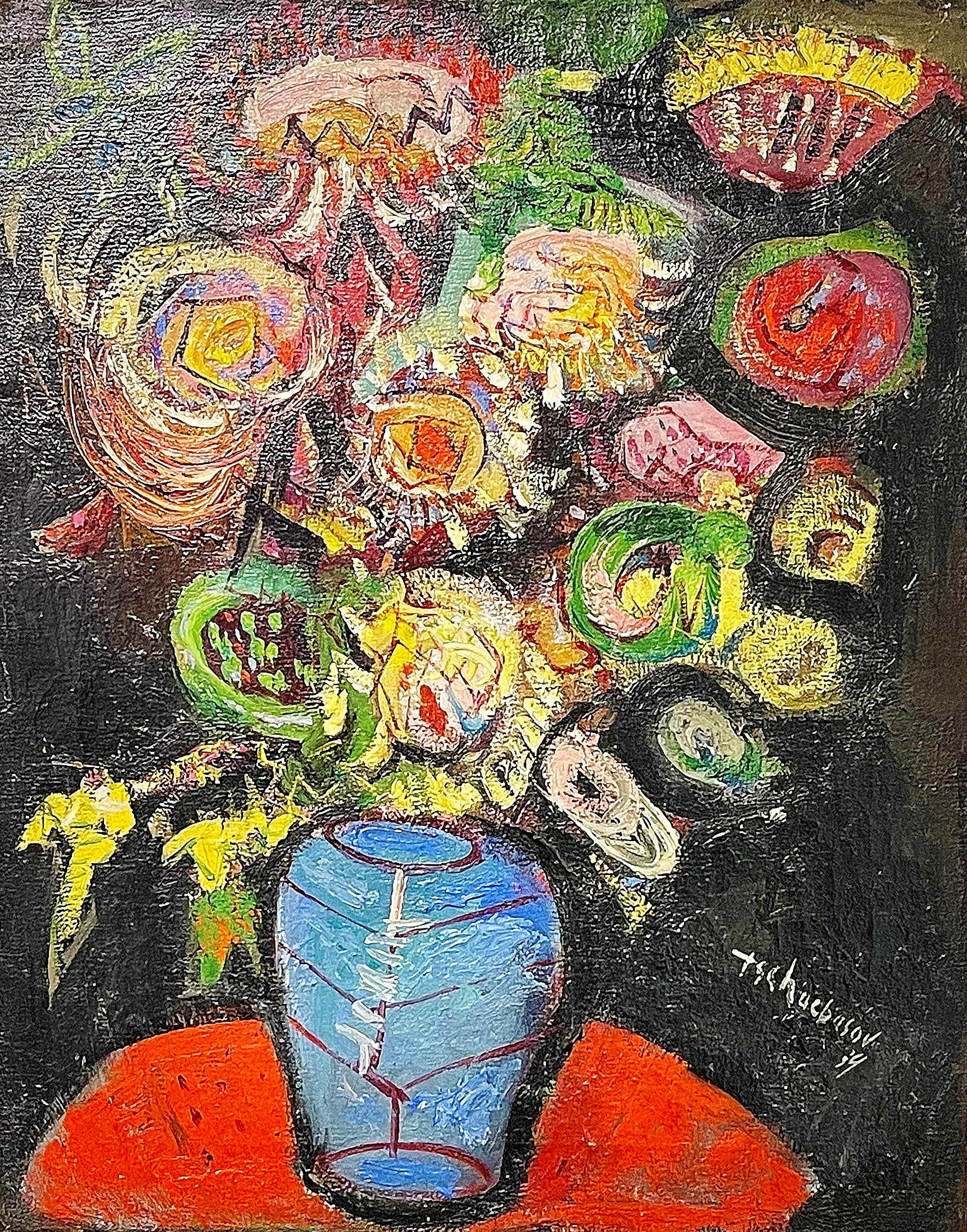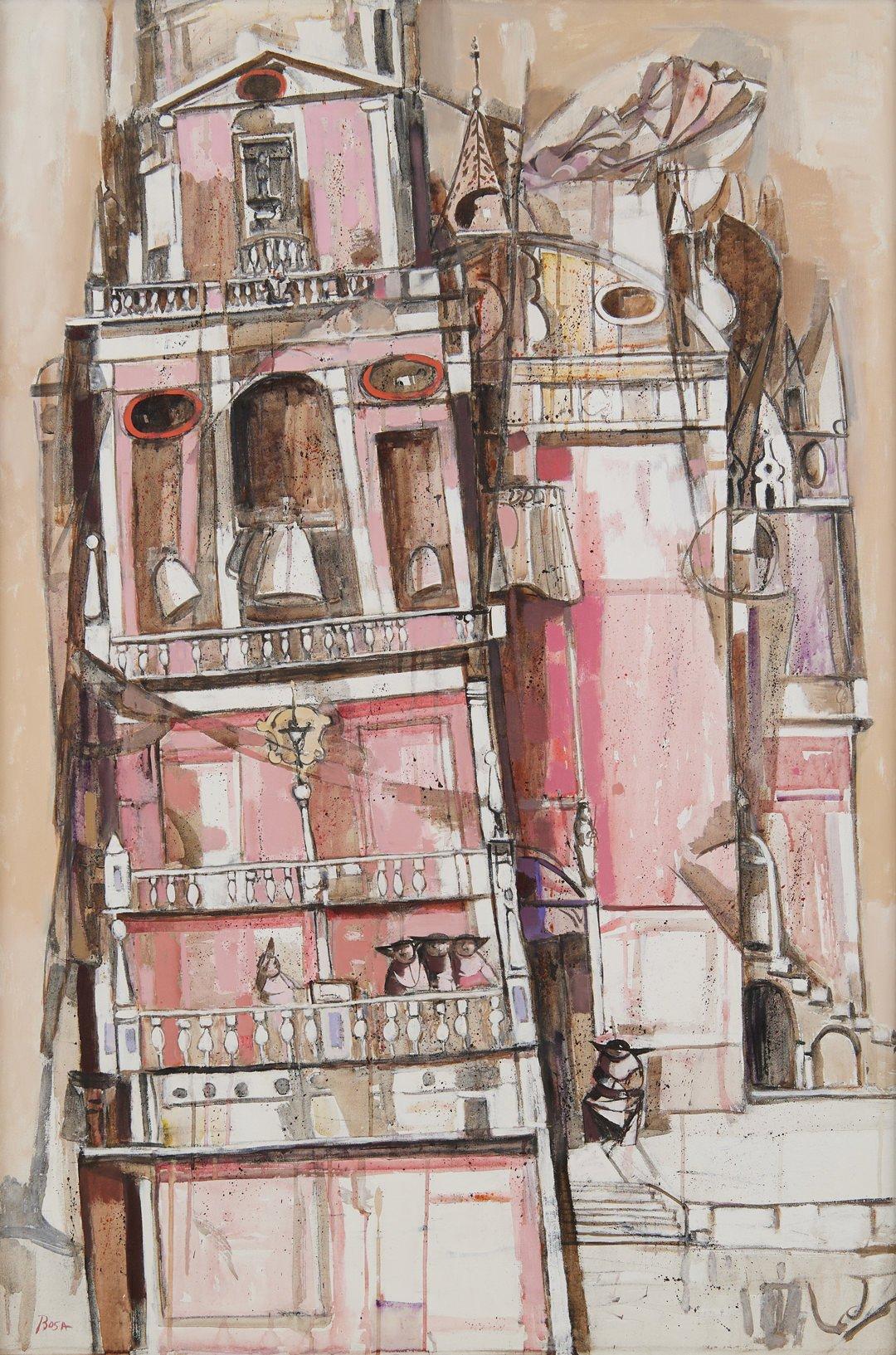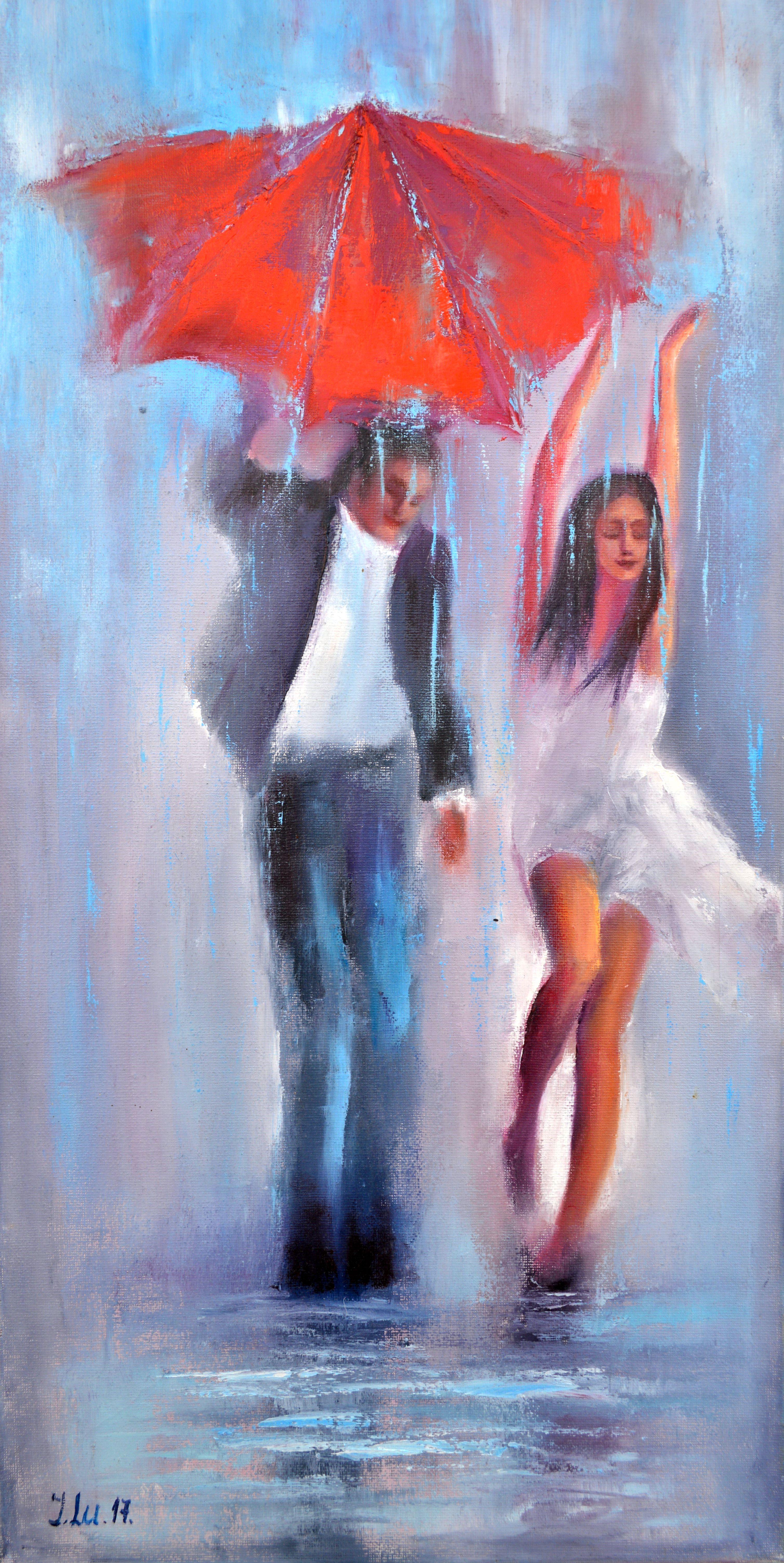Items Similar to "Interior Scene with Figure" Expressionistic Style Oil Painting on Masonite
Want more images or videos?
Request additional images or videos from the seller
1 of 18
Michael Baxte"Interior Scene with Figure" Expressionistic Style Oil Painting on Masonite1969
1969
About the Item
A strong modernist oil painting depicted in 1969 by Russian painter Michael Baxte. Mostly known for his abstracted figures on canvas or street scenes, this piece is a wonderful representation of his bold still life paintings, with expressive use of color, shape, and form. Later in his career, Baxte explores Expressionism, infusing both European and North American stylistic trends. This piece is from later in his career, but we can feel this underlying style throughout.
Art measures 21.75 x 18 inches
Michael Posner Baxte was born in 1890 in the small town of Staroselje Belarus, Russia. For the first half of the 19th century it was a center of the Chabad movement of Hasidic Jews, but this group was gone by the middle of the 19th century. By the time the Baxte family immigrated to the United States at the beginning of the 20th century, the Jewish population numbered only on the hundreds. The native language of the Baxte family was Yiddish. It is likely that the death of Michael Baxte’s father triggered the family’s immigration. Three older brothers arrived in New York between 1903 and 1905. Michael and his mother, Rebecca, arrived in 1907. By 1910 Michael, his mother, and brother, Joseph, were living in New Orleans and may have spent some time on a Louisiana plantation. Around 1912, Michael Baxte returned to Europe to study the violin. In 1914 he, his mother, and Joseph moved to New York City.
Meanwhile, in Algeria, a talented young woman painter, Violette Mege, was making history. Since for the first time, a woman won the prestigious Beaux Art competition in Algeria. At first, the awards committee denied her the prize but, with French government intervention, Mege eventually prevailed. She won again 3 years later and, in 1916, used the scholarship to visit the United States of America. When Violette came to New York, she met Baxte, who was, by then, an accomplished violinist, teacher, and composer. Baxte’s compositions were performed at the Tokyo Imperial Theater, and in 1922 he was listed in the American Jewish Yearbook as one of the prominent members of the American Jewish community. As a music teacher he encouraged individual expression. Baxte stated, “No pupil should ever be forced into imitation of the teacher. Art is a personal experience, and the teacher’s truest aim must be to awaken this light of personality through the patient light of science.”
By 1920 Michael Baxte and Violette Mege were living together in Manhattan. Although they claimed to be living as husband and wife, it seems that their marriage did not become official until 1928. On their “unofficial” honeymoon around 1917, in Algiers, Baxte confided to her his ambition to paint. There and later in New Mexico where the wonderful steeped sunlight approximates the coloring of Algiers, she taught him his heart’s desire. He never had any other teacher. She never had any other pupil. For ten years she devoted all her time, energy, and ambition to teaching, encouraging, inspiring him. Then in 1928, their mutual strivings were rewarded, as his works were being chosen as one of the two winners in the Dudensing National Competition for American Painters. Out of 150 artists from across the country participated in the Dudensing, and Michael Posner Baxte and, Robert Fawcett, were the winners.
In his 1924 naturalization application, he indicated that he was sometimes known as “Michael Posner Baxte.” One of the witnesses to his application was Bernard Karfiol, a Jewish American artist. That’s when Michael may have decided to use the name Baxte for his art. Baxte, née Posner, received critical acclaim from art critics. In 1929, Lloyd Goodrich of The New York Times wrote, “Mr. Baxte has a way of choosing aspects of the world that are quite unhackneyed… He is an artist of considerable subtlety, not too strong perhaps, and sometimes a little uncertain, but always sensitive and interesting. One feels in each of his pictures an absorption in his subject and an individual manner of looking at it. He has a very attractive color sense, warm, sensuous, and unexpected, which seems natural and unforced.” A dozen years later another New York Times art critic, Howard Devree, commented, “Also at the Bonestell are paintings by Michael Baxte, who lays in his color with gusto and considerable acumen.”
During the 1930’s Baxte and his wife, Violet, lived in France and spent most of their time in Paris, where Baxte became part of the School of Paris and exhibited his artwork in government sponsored exhibitions including the Salon d' Automme, helping as well to organize an exhibition of American painters. When the World War II began, and Paris became unsafe Baxte and his wife relocated to Mexico where they continued to live and work. Baxte died in 1972 in Mexico.
PROVENANCE: Private collection; Lilac Gallery Collection. The piece will be stamped from Lilac Gallery on its verso.
- Creator:Michael Baxte (1890 - 1972, Russian)
- Creation Year:1969
- Dimensions:Height: 21.75 in (55.25 cm)Width: 18 in (45.72 cm)Depth: 0.25 in (6.35 mm)
- Medium:
- Movement & Style:
- Period:
- Condition:This piece is in excellent condition besides some wear on outer edge of the board from age.
- Gallery Location:New York, NY
- Reference Number:
About the Seller
5.0
Platinum Seller
These expertly vetted sellers are 1stDibs' most experienced sellers and are rated highest by our customers.
Established in 2012
1stDibs seller since 2015
1,482 sales on 1stDibs
Typical response time: 1 hour
- ShippingRetrieving quote...Ships From: New York, NY
- Return PolicyA return for this item may be initiated within 7 days of delivery.
More From This SellerView All
- "Venetian Powder Room Scene with Figures" Impressionist Oil Painting on CanvasBy Luigi CaglianiLocated in New York, NYA whimsical oil painting depicting a Venetian Powder Room Scene with Figures getting ready for the masquerade. A truly intimate scene with a ornate mirror, flowers in a vase and whit...Category
Early 20th Century Impressionist Interior Paintings
MaterialsCanvas, Oil
- "Figures Seated around a Table with Flowers" Post-Impressionist Oil PaintingBy Jacques ZuckerLocated in New York, NYAn outstanding oil painting depicitng 3 figures seated around a table with flower vase. The bright colors and quick brush strokes are what makes this piece so attractive and desirabl...Category
20th Century Post-Impressionist Figurative Paintings
MaterialsCanvas, Oil
- "Young Boy with Toy Airplane" Post-Impressionist French Oil Painting on CanvasBy Jacques ZuckerLocated in New York, NYThis painting depicts a whimsical portrait of a young boy with light brown hair against a viridian green background. The piece is done in a highly impressionistic manner and is a won...Category
20th Century Post-Impressionist Figurative Paintings
MaterialsOil, Wood Panel, Canvas
- "Interior Scene with Figure and Flowers" Post-Impressionist Oil Painting FramedBy Jacques ZuckerLocated in New York, NYAn intimate interior scene of a woman reclining in her living room with a bouquet of flowers on a sunny afternoon. We are charmed by the rich choice of color and intimate details thr...Category
20th Century Post-Impressionist Interior Paintings
MaterialsPanel, Oil
- "Sunday at the Chateau de Chambord" Impressionist Interior Scene with PianoBy Cindy ShaoulLocated in New York, NYA charming depiction of an interior scene with piano. A cozy impressionistic scene with warmth and feeling. Whimsical details through out and beautiful brushwork. This piece captures...Category
2010s Contemporary Interior Paintings
MaterialsCanvas, Oil
- Mother and ChildBy Paul Alexandre Alfred LeroyLocated in New York, NYA wonderful depiction of mother and child displayed in a gold round ornate frame with intricate details.Category
Late 19th Century Realist Figurative Paintings
MaterialsCanvas, Oil
You May Also Like
- Still Life with Blue VaseBy Nahum TschacbasovLocated in Lawrence, NYEstate of artist. Russian-Jewish-American artist Nahum Tschacbasov (1899-1984) is known for his intriquing cubo-surrealistic-symbolist works which feature a strong psychological ele...Category
1930s Expressionist Figurative Paintings
MaterialsAdhesive, Oil
- Cathedral in Venice, large 20th century oil painting, Italian-American artistBy Louis BosaLocated in Beachwood, OHLouis Bosa (American, 1905-1981) Cathedral in Venice Oil on canvas Signed lower left 60.25 x 40.25 inches 66.5 x 46.5 inches, framed Born in Codroipo, a small village only a few mi...Category
Mid-20th Century Expressionist Figurative Paintings
MaterialsOil
- Dancing in the rain 60X30 oil, Valentine’s Day gifts artLocated in Sempach, LUIn this vibrant oil painting, I've captured the essence of unbridled joy and carefree abandon. Two figures dance beneath a crimson umbrella, their movements a blend of expressionism ...Category
2010s Expressionist Interior Paintings
MaterialsOil, Canvas
- Red dress 60X80 oil, Valentine’s Day gifts artLocated in Sempach, LUIn this embodiment of passion and serenity, crafted with oil on canvas, my hand wove the essence of raw emotion into every stroke. I melded expressionism's vigor with realism's detai...Category
2010s Expressionist Figurative Paintings
MaterialsOil, Canvas
- Lady in Red 60X80 oil, Valentine’s Day gifts artLocated in Sempach, LUThis artwork is a passionate symphony in oil, where expressive strokes and vibrant hues of red capture the essence of emotion and movement. It blurs the lines between realism and exp...Category
2010s Expressionist Figurative Paintings
MaterialsOil, Canvas
- Large French Expressionist Oil Painting, Girl, Poupèe, the Doll, Ecole de ParisLocated in Surfside, FLSigned on recto and signed verso, titled, and inscribed Montmartre by the artist. This is a large colorful expressionist painting of a girl doll with long blonde or ginger redhead pigtails. It is titled Poupee 1925 and depicts an Art Deco era flapper girl in a beret. Roger Crusat (French Expressionist artist, poet and lithographer) is known for ballet troupe set design and theatre backdrop painting and architectural motifs. Roger Crusat was born in 1917 in Roussillon, Provence, France. Crusat's early works depict the colorful countryside of Provence in the South of France, As a young man Crusat performed many jobs in the troupe, designing costumes, and even dancing. But, most important, he painted the scenery for the troupe's performances. It was while working in this capacity that he learned the essentials of scenery painting that remain evident in his mature work. Crusat was a student of Andre Fons-Godail at Beaux-Arts in Perpignan when he was called to serve in World War II. After being wounded in 1940, he returned to study under Rene Jaudon at Beaux-Arts in Paris. Crusat was known by his contemporaries as "the Catalan painter of Montmartre" where he lived with his wife until his death in 1994. Cracked and peeling walls framed by rusting water pipes are a common sight in Montmartre. What others considered unnecessary, Crusat included. Water pipes were his cherished motif. Supposed by some to be a symbol of decay and monotony, Crusat's Impressionist water pipes like arteries in the body, convey life. Crusat won the prestigious Prix Populiste for his "Descente d'Eau" (Water Pipes) in 1956. Crusat's mature work retains the essentials of good scenery painting. Intricate detail will not be found, but broad, solid abstract shapes abound. His subtle colors, dense in texture, are meant to compliment his subjects, not distract from them. The critics considered him a lyric expressionist and a "painter of Man" in his portrayal of the anguish of daily life and the regrets of the past. Crusat exhibited at many of the same Salons as the post-impressionists and expressionists. Salon des Independants was co-founded by Georges Seurat. Degas had only one exhibition during his lifetime, and it was at the Galerie Durand Ruel in Paris. Gauguin had also exhibited his Tahitian paintings. Crusat's works were exhibited there in 1955. SELECT AWARDS 1954 Le Prix de la Jeune Peintre 1955 Prix des Amateurs d'Art & des Collectionneurs, Galerie Gazette des Beaux Arts, 140 rue Faubourg St. Honore, Paris Les Jardins des Abbesses purchased by the Republic of France, Prix de la Ville de Marseilles, Prix Othon Friesz 1956 Prix Populiste, Prix de Amedeo Modigliani 1957 Grand Prix International de Vichy, Prix de la Fondation Greenshields 1959 IVeme Grand Prix de Peinture du Festival de Vichy 1967 Le Prix des Amis de Brantôme, Perigord, France 1970 Prix de la Critique Academy de Vernet a Vichy,"La Nuit, Premiere Etude" Roger Crusat, Half-closed shutters , poems enriched with four original lithographs (175 numbered copies) drawn on Henri Deprest's presses on February 13, 1975 , Éditions Matignon 34, 1975. Personal exhibitions Durand-Ruel Gallery, Paris, 1955 [ 1 ] . Galerie Rivière, Paris, november 1958 [ 4 ] . Le Roux and Mathias, auctioneers in Paris, Sale of the Roger Crusat workshop , Hôtel Drouot , Paris, Thursday October 27, 1994 [ 5 ] . Jack's American Bistro, Glens Falls , September- october 2004 [ 6 ] . Collective exhibitions Galerie Roger, Lyon , October 1946 [ 7 ] . Salon des Indépendants , Paris, from 1952 [ 8 ] . Exhibition Discover , Galerie Charpentier , Paris, 1955. Populist Salon, Paris, 1956. Salon des Amis de Brantôme, 1957. Hundred painters and oil - Exhibition on the occasion of the centenary of the first oil drilling , Musée Galliera , october 1958 [ 9 ] . “An artist from Roussillon whose invoice calls for a flattering comparison with that of a Soutine or a Rebeyrolle . Indeed, following their example, he focuses on familiar scenes: Girls on the balcony or in the basket , Laundresses weighing heavily on the iron, draft horses or plucked turkeys, who stand next to a magnificent portrait of a man in a red dressing gown . Hasn't the Prix Populiste already crowned its merits? " - Jean Jacquinot SELECT EXHIBITIONS Galerie La Gentilhommiere, Paris La Salle Arago, Perpignan, Salon des Indépendants, Salon d'Automne Biennale de Menton, Menton Galerie des Jacobins, Lyon Galerie Durand-Ruel, Paris Salon de la Nationale Galerie Bassano, Paris Salon Populiste Salon de Romans Galerie Motte, Geneva, Switzerland Exposition à Quiberville sur Mer - Normandie Galerie Charpentier Salon Confrontation: Bernard Buffet, Roger Crusat, Jean Jansem, Franck Innocent, Jean-Jacques Morvan...Category
Mid-20th Century Expressionist Figurative Paintings
MaterialsCanvas, Oil
Recently Viewed
View AllMore Ways To Browse
19th Century Mexican Oil Paintings
19th Century Violin
Small 1890s Painting
1910s Russia
Violin Still Life
Dior Violet
Small 1910s Painting
Rebecca Well
Still Life With Violin
Rebecca Of Wells
Rebecca Of The Well
Rebecca At The Well
Dior Lilac
Used Yearbooks
France 1960 Street Light
Algerian Woman
Louisiana Plantation
Yiddish Theater





